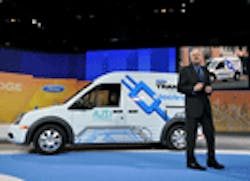Ford introduces all-electric Transit Connect
The long-awaited 2011 model Transit Connect Electric van from Ford Motor Co. made its debut at the Chicago Auto Show last week – an all-electric light-duty commercial vehicle targeted to go into production later this year.
Transit Connect Electric is the first product in Ford’s accelerated electrified vehicle plan, the company said, to be followed by the Focus Electric in 2011, a plug-in hybrid electric vehicle in 2012 and next-generation hybrid technology in 2012. With targeted range of up to 80 mi. per full charge, the all-electric Transit Connect will be rechargeable using either 240-volt or standard 120-volt outlets
“Transit Connect Electric is ideal for fleet owners that have well-defined routes of predictable distances and a central location for daily recharging,” noted Derrick Kuzak, Ford’s group vp-global product development, at the unveiling. “Not only is this an ideal vehicle for eco-conscious fleet operators, it is an important part of Ford’s future.”
[Click here to watch a video of the Transit Connect Electric in operation.]
The all-electric van is built in partnership with Azure Dynamics Corp., using Azure’s Force Drive battery electric powertrain and Johnson Controls-Saft’s lithium-ion battery technology.
Ford originally partnered with Smith Electric Vehicles, an associate company of England’s Tanfield Group, on this all-electric van. But in November 2009, Tanfield – citing strong feedback for its own Smith Newton electric truck models rolled out in the U.S. last summer – dissolved the partnership, saying it would dedicate resources to building a base for the Newton rather than assisting a competitor in the electric-truck market.
Some of the funding to develop the Transit Connect Electric came from a $5.9 billion loan to Ford from the Dept. of Energy (DOE) finalized last September, helping finance up to 80% of qualified expenditures at the automaker to improve the efficiency of light vehicles by using technologies that improve internal combustion engines and transmissions, reduce vehicle weight, reduce vehicle drag with more aerodynamic designs, and improve vehicle efficiency through the development of hybrid, plug-in, and all-electric vehicles.
“This investment is part of our commitment to creating the clean energy jobs of the future while supporting American innovation,” U.S. Energy Secretary Steven Chu said at the time. "We can revitalize the American auto industry and at the same time reduce our dependence on oil and cut our carbon pollution.”
[Click here to view DOE Secretary Chu’s recent speech at the 2010 Washington Auto Show laying out the “clean vehicle” future of the U.S.]
The Transit Connect Electric and its gas-powered twin share a range of common specifications, Ford noted. Both offer 135 cubic ft. of cargo volume with 59.1 in. of floor-to-ceiling load height and 47.8 in. of load width between the wheel arches; 72.6 in. of load length, which translates to more than 6 ft. of cargo floor space; split rear cargo doors that open at a standard 180 deg., or an optional 255 deg.; and power-assisted rack-and-pinion steering which allows a 39-ft. curb-to-curb turning circle for maneuverability in tight urban spaces.
Yet Praveen Cherian, Ford’s program manager for the Transit Connect Electric, noted there are potentially major advantages due to the vehicle’s all-electric powertrain – mainly by offering lower cost of operation, as recharging with electricity is generally less expensive than refueling with gasoline, plus lower maintenance costs over the life of the vehicle.
For example, Cherian said the number of components typical in an internal combustion engine and transmission are dramatically reduced in an electric vehicle to just a few moving parts in the electric motor and transaxle, which results in fewer parts to wear out or maintain. Electric vehicles also use completely sealed cooling systems that do not require refilling, replacement or flushing , along with no oil changes or tune-ups needed.
“There are no belts to wear out or break and no spark plugs or injectors to clean or adjust, there is no exhaust system to replace and no liquid fuel system to freeze or clog, and the use of regenerative braking reduces wear and tear on brake pads,” Cherian added.
By combining car-like driving dynamics with cargo hauling capacity and low operating costs, the Transit Connect is an ideal choice for electrification, noted Scott Harrison, CEO of Azure Dynamics. “From an industry standpoint, we are seeing delivery fleet and utility vehicle operators move to smaller, more fuel-efficient vehicles,” he said.
About the Author
Sean Kilcarr
Editor in Chief
Sean Kilcarr is a former longtime FleetOwner senior editor who wrote for the publication from 2000 to 2018. He served as editor-in-chief from 2017 to 2018.
